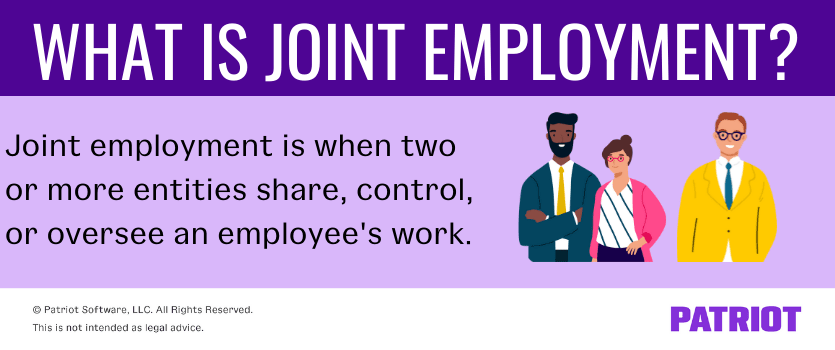If you have employees through a staffing agency or share your employees with another employer, you are likely a joint employer. And if you’re a joint employer, you need to know about joint employment. So, what is joint employment, and what is a joint employer exactly? Find the answers to these questions and more below.
Joint employers and joint employment
The joint employer definition is two or more employers overseeing the work of at least one employee. Joint employment occurs when two or more business entities share, control, or oversee the employee’s work.

There are two types of joint employment: vertical and horizontal.
Vertical joint employment
Vertical joint employment may be one of the most common forms of joint employment. In this type, the employee is employed by one employer but is financially dependent on another business or entity involved in the work.
Examples of vertical joint employment include:
- Staffing agencies
- Subcontractors
- Intermediary employers
- Labor providers
For example, you need a temporary administrative assistant for six weeks while another employee is out on leave. You contact Staffing Agency A to locate a temporary employee for your business. The temporary employee works for you but Staffing Agency A officially employs the temporary employee. The employee works for both you and the staffing agency.
Because the staffing agency officially employs the temporary employee while they perform work for you, the relationship between both employers is vertical. You hire the staffing agency to find and pay the employee, and you oversee the employee’s work.
Horizontal joint employment
Horizontal joint employment occurs when two or more business entities share the employee’s work or services. Generally, horizontal joint employment occurs when the employer shares one or more of the following:
- Ownership
- Management (e.g., directors)
- Administrative operations (e.g., payroll)
- Agreements between employers
- Clients or customers
- Shared supervision of the employees
- A pool of employees shared between businesses
- Intermingled operations (e.g., work performed)
An example of horizontal joint employment is a franchise operation. Let’s say you own two ice cream locations that are separate legal entities. You have different managers for each location, and both managers have their own employees they oversee. But, Manager A requests that Employee B work at their location for two shifts per week. Both locations now have joint employment of Employee B because the employee works at both locations for two different managers and legal entities.
FLSA joint employment
So, what’s the big deal about joint employment? In 2020, the federal government made changes regarding joint employment under the Fair Labor Standards Act (FLSA). The guidelines (aka the Joint Employer Rule or JER) published on January 16, 2020 and went into effect on March 16, 2020.
However, JER guidelines are only in effect until September 28, 2021 because the DOL removed these guidelines in 2021 (which we’ll get to in a minute).
What does the 2020 JER do? The Department of Labor, which oversees enforcing the FLSA rules, further defined the meaning of a joint employer in the ruling. Under the JER, an employer determined if they were a joint employer by examining who:
- Makes hiring and firing decisions
- Supervises and controls the employee’s work, schedule, or employment conditions
- Determines how an employee is paid and the rate of pay
- Stores and maintains employment records
With the JER, an employer must actually, either directly or indirectly, exercise one of the four factors of joint employment. What does this mean? To be considered a joint employer under the updated guidelines, the employer must make the decisions and not just have the power to make the decisions.
For example, you own a plumbing business and have employees. A general contractor contacts you to use your services, and you send one of your employees to perform the work. The contractor provides the materials and equipment and your employee performs the work. But, the contractor does not make any of the controlling decisions stated under the FLSA’s updated guidelines. So, the general contractor is not a joint employer.
However, if the general contractor did make controlling decisions about the employee’s work, schedule, or conditions of employment, you do have a joint employer relationship with the contractor.
Updated FLSA joint employment rulings
On July 31, 2021, the DOL Wage and Hour Division released new guidance that removes the JER guidelines. Effective September 28, 2021, the DOL will enforce the FLSA joint employer guidelines in place prior to March 16, 2020.
The ruling that rescinded the JER states that the JER improperly conflicted with the standard DOL interpretation of joint employment. And, the ruling stated that the JER improperly narrows vertical joint employment.
Again, the JER is in effect until September 28, 2021. On this date, the JER is entirely removed and no longer applicable.
When the JER is removed, the scope of vertical joint employment widens again. Business owners who use workers formally employed with other businesses are again considered joint employers, regardless of actual decision-making control.
If you have the power to make decisions concerning the employee who works for you and another company, you have joint employer status.
Role of the FLSA in joint employment
So, why does the FLSA oversee employers with joint control of employees? The FLSA determines fair labor and wage standards for employees. The goal of governing joint employment is to find and hold accountable employers who violate these standards.
Joint employers are equally liable for hour and wage violations, such as failure to pay overtime to employees who perform work for both companies.
For example, an employee of a franchise works 35 hours per week at Location A and 10 hours per week at Location B. With joint employment, the employee must receive overtime wages for any hours worked over 40. The employee worked 45 hours between both locations (35 + 10) and is entitled to five hours of overtime (45-40).
Or, say an employee works at your business for 41 hours per week, but you used a staffing agency to hire the employee. The employee must receive one hour of overtime worked (41-40), and the hours cannot be split between your business and the staffing agency.
Joint employers and FMLA
If you are a joint employer under FLSA regulations, all entities that employ the worker must report that worker for Family and Medical Leave Act (FMLA) purposes. The FMLA lists primary and secondary employers in joint employment situations. Consider the following questions to determine whether your business is the primary or secondary employer:
- Which business entity has the authority to hire, fire, place, or assign work to the employee?
- Who decides how, when, and the amount that the employee is paid?
- Who provides the employee’s leave or other unemployment benefits?
The primary employer typically provides the benefits, pays the employee and makes employment decisions.
Under FMLA joint employment, both employers must count the employee when determining the FMLA employer coverage and employee eligibility. The employee’s worksite is the primary employer’s worksite unless the employee works onsite for the secondary employer for at least one year.
Primary employers are responsible for:
- Giving required notices
- Providing FMLA leave
- Maintaining group health insurance benefits during FMLA leave
- Restoring the employee to the same or an equivalent job upon their return
Secondary employers are responsible for:
- Not interfering with the employee’s rights to FMLA leave
- Remaining compliant with FMLA regulations for the regular, permanent workforce
- Keeping basic payroll and employee identification data for jointly-employed workers




